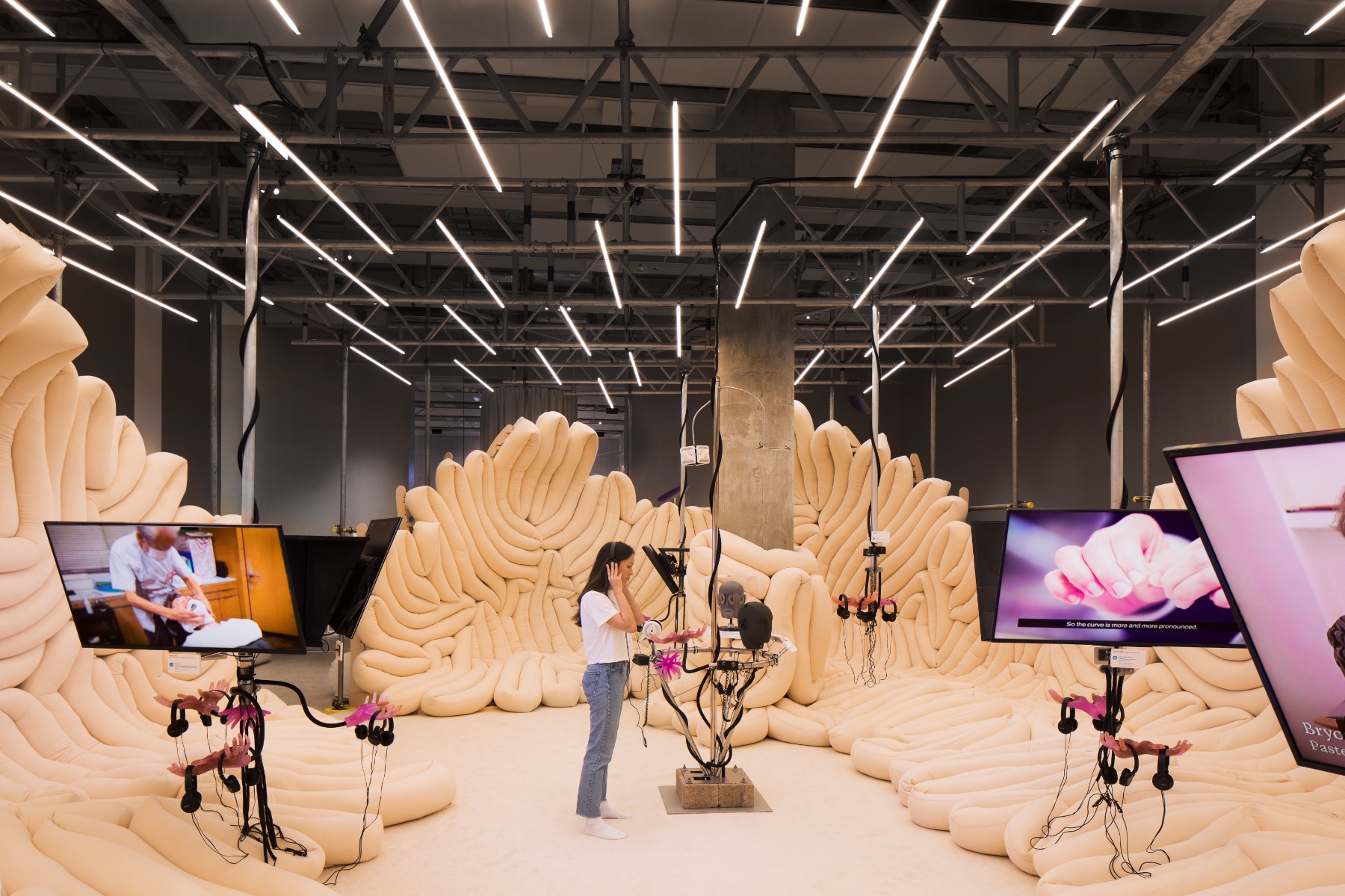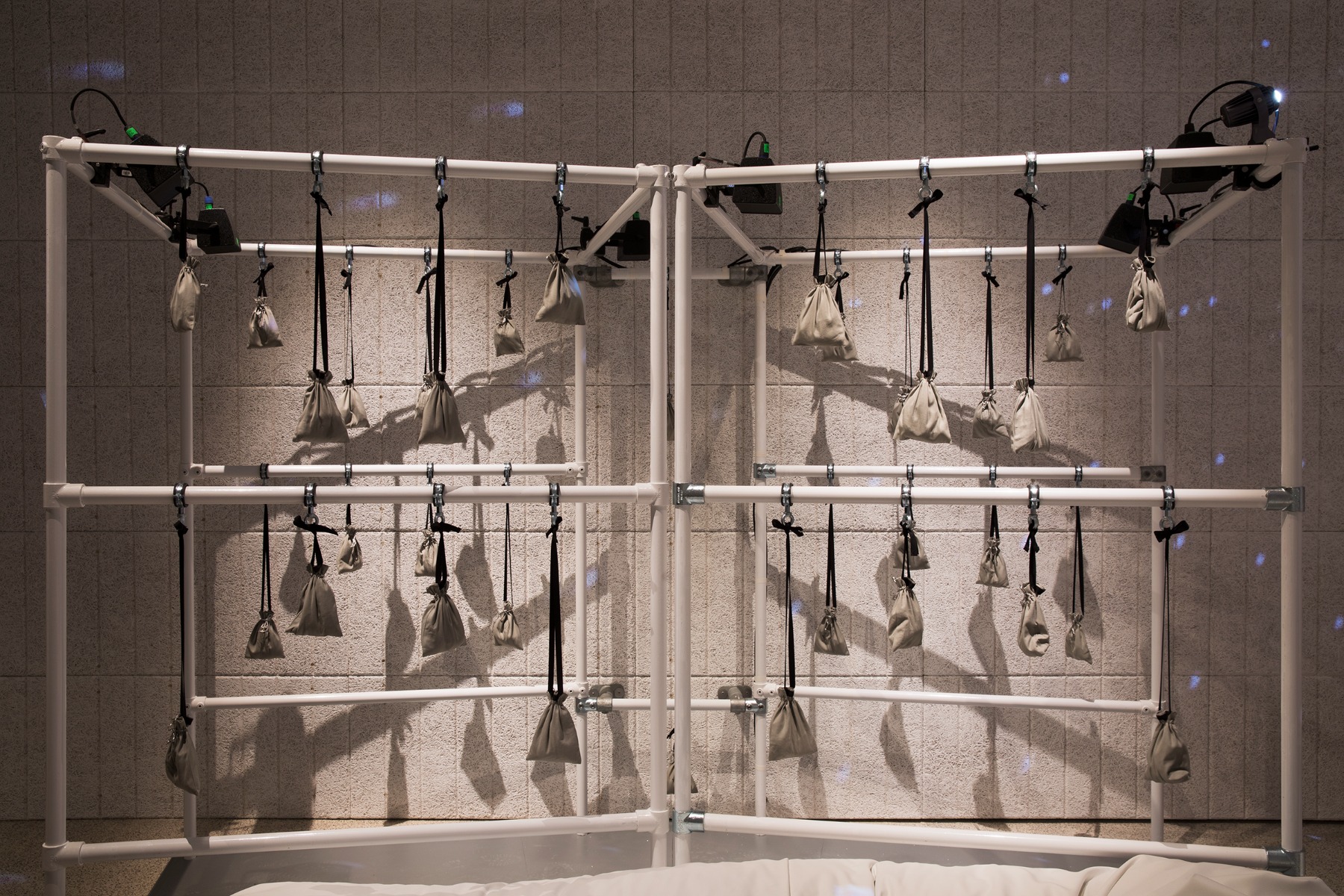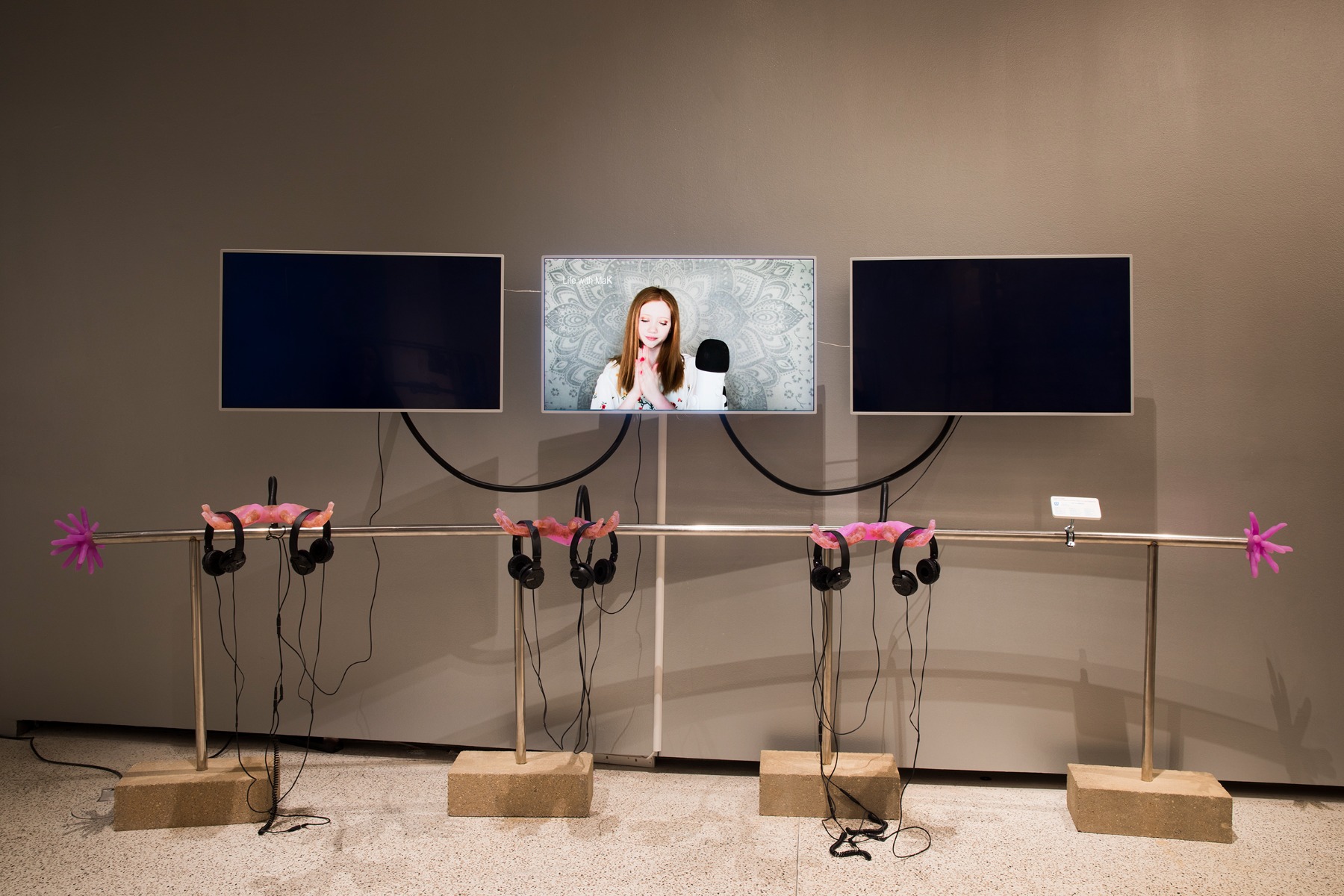
The Thermal Bath of Good Sensations
The immersive exhibition Weird Sensation Feels Good created by curator James Taylor Foster in collaboration with the Latvian architecture studio ĒTER is on view until October 16 at the London Design Museum. This ASMR-devoted installation displays the genuine excitement triggered by intimate openness in a collective space as well as unabashed self-introspection. As if in a metaphorical retreat centre, visitors are invited to dive into a deeply individual and yet shared therapeutic process. Communication with the viewer is maintained through quite familiar categories. While efficiently providing a very well known and inviting base layer, the exhibition not only directly addresses those who penetrate conceptual riddles on a day-to-day basis but also neatly becomes a “gateway drug” for inexperienced exhibition visitors.
Weird Sensation Feels Good. Exhibition view at the London Design Museum. Photos: Ed Reeve
A strange tingling down your spine, or so-called brain-gasms, have undoubtedly existed since the beginning of time, but thanks to apps such as Tik Tok and YouTube, ASMR (Autonomous Sensory Meridian Response) has become a sensational phenomenon in recent years – watching videos that stimulate the mind and cause one to experience pleasant, peace-enhancing sensations is now a popular activity worldwide. Unsurprisingly, all kinds of self-care trends are currently hitting the top of the charts, and an increase in the frequency of anxiety and panic attacks among the myriad of mental health challenges that the general public now faces has fed a growing necessity for safe mental and physical spaces. Weird Sensation Feels Good aims to provide this kind of calming environment and showcases self-healing possibilities as inspired by the post-internet age. A wide range of digital antidepressants are available in this first-aid kit for the “laptop generation”, starting with accidental ASMR triggers – such as Björk’s touchingly innocent narration about her TV, or the relaxing video of a poodle being groomed – along with exciting “ASMRtist”-made (intentional) interactive tools and sight-sound-touch sensation triggers.

While mind-body balancing trends are spreading, there’s a possibility that the ambiguous body-aesthetics discipline will also come back into style. In the 90s, Richard Shusterman’s Soma-Aesthetics Project[1] made a peculiar philosophical maneuver by addressing the experience, consciousness and wisdom of thought that our bodies hold. Although this project was once ridiculed in the German newspaper F.A.Z as “reading Heidegger while doing breathing exercises” and “spanking yourself while reading Kant”, it can deftly perpetuate the idea that a body holds great qualities for being a site of contemporary artwork. In this sense, it serves not only external performative purposes like a brush or a canvas, but also as an internal surveillance station of bodily processes.

Looking much like puffy brain wrinkles as seen from the inside of the brain, the invitingly surreal set design of the exhibition could literally represent “a nice place in your mind”, or similarly, “a sanctuary” that can be seen as one peers through soft surrounding palms. In between the cosy sausage-pillow lines we can catch a peeping glimpse of our daily zeitgeist, relentless in our spiritual, physical and aesthetic design quests for comfort, softness and security. The intention to create an open space for public intimacy has left a number of traces (including possible analogies of internet streaming and water streams) that reference already existing architectural monuments of cultural history. Ancient Roman thermae demonstrated a culturally essential form of ritual similar to Budapest’s thermal baths, where still nowadays seniors play chess while sitting in the water on the pool’s stairs. These traditional “spa” complexes once served as refreshment for both body and spirit, and they were important social hubs. Foster’s delicately curated “stimulators of good sensations”, together with the ethereal, soft-as-a-cloud exhibition architecture by ĒTER, creates a spatial organism that provokes its own kind of “performance”. The exhibition directs sensual attractions that generate peculiar psychological impulses and unexpectedly pleasant social dynamics. Even if Weird Sensation Feels Good is being presented as being in the field of architecture and design, and the participants call themselves ASMR-tists rather than artists, the exhibition reveals physical and emotional sensations as a category of aesthetics and inevitably leads one to think about the limitlessness of synthesized art forms.

The exhibition’s architecture, together with the sensory observance hubs, takes you to a whole different state of consciousness, similar to the one we enter when reading an exciting novel, falling asleep, or watching a gripping movie. For a brief moment, visitors “forget” where they have come from. It reminds one of the installation art of the 80s and 90s – its encompassing qualities and the specific states of mind it triggered, such as psychological absorption. Weird Sensation Feels Good noticeably overlaps with Aristotelian catharsis, dreams, captivating fiction, and total installations – one is not just surrounded by the physical scenarios of the space but one’s mind is also completely submerged. In a similar manner to Brazilian artist Hélio Oiticica’s perception experiments of the 60s and 70s that strove to reach the “supra-sensorial”[2], the audience is invited to go in the same direction, preferably prior to conceptualizing the process. The usual functionality of design and architecture is extended with emotional, physical and intellectual engagement.

With steadily increasing excitement, the space navigates the viewer to discover new perceptual adventures, finally leading to an absolute culmination of comfort. The exhibition gradually unfolds as an “amusement park” of relaxing sensations. Deflecting to references of the entertainment industry and bodily sites of artwork, a diametrically opposite interpretation of the topic was once presented by Lithuanian visionary Julijonas Urbonas’ model Ethanasia Coaster[3]. Juggling between the fields of art, design and science, Urbonas evokes bodily sensations with his newly explored Gravitational Aesthetics, which unlike the pleasant tingles of this exhibition, may twist your stomach and give you chilling goosebumps. Urbonas has designed a synesthetic roller coaster model for eliciting a potentially pleasant and exciting death, as well as the free-fall installation Airtime, in which it is possible to lose your usual starting point of interaction with the outside world. These artworks allow us to observe physical and imaginary sensations accompanied with completely unfamiliar inner processes. Drawing back from Urbonas’ architectural “fight or flight” responses to Foster’s “flow & flourish” healing approach, it’s clear that both cases reflect the artistic legitimacy of body aesthetics.

The exhibition text interrogatively states: "If ASMR is filling a void, we must ask what has created this void," suggesting that it embodies a solution to a yet unrecognized problem. Perhaps foreseen techniques of feeling good do not necessarily need to become an artistic paradigm shift, but in this exhibition, they highlight the problem areas of the current era as well as refreshingly invert the usual outward-facing sight of the artwork. There’s a reason to believe that “directing architecture” and “performing spaces” that seek to reconnect bodies and minds in a collective environment can be a useful tool for today’s solitary, nervous individual, perhaps even a suitable form of self-medication.

[1] Shusterman, R. Somaesthetics: A Disciplinary Proposal. The Journal of Aesthetics and Art Criticism. J-STOR 1999. Available: https://www.jstor.org/stable/432196?seq=1
[2] https://www.tate.org.uk/art/art-terms/s/supra-sensorial
[3] Rudovska, M. From a pleasurable death to performing particles. Arterritory, 2016. Pieejams: https://arterritory.com/en/visual_arts/interviews/17818-from_a_pleasurable_death_to_performing_particles/